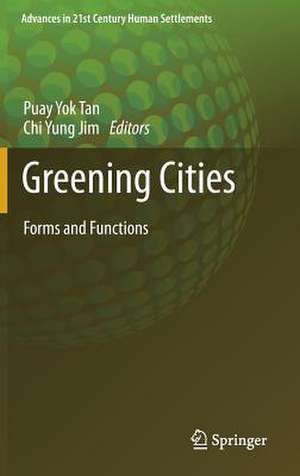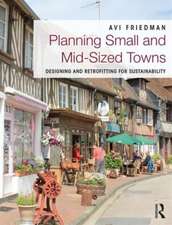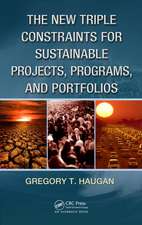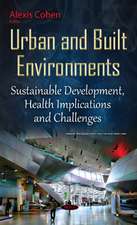Greening Cities: Forms and Functions: Advances in 21st Century Human Settlements
Editat de Puay Yok Tan, Chi Yung Jimen Limba Engleză Hardback – 5 apr 2017
| Toate formatele și edițiile | Preț | Express |
|---|---|---|
| Paperback (1) | 731.28 lei 6-8 săpt. | |
| Springer Nature Singapore – 12 dec 2018 | 731.28 lei 6-8 săpt. | |
| Hardback (1) | 1009.70 lei 6-8 săpt. | |
| Springer Nature Singapore – 5 apr 2017 | 1009.70 lei 6-8 săpt. |
Din seria Advances in 21st Century Human Settlements
- 23%
 Preț: 1043.61 lei
Preț: 1043.61 lei - 15%
 Preț: 701.40 lei
Preț: 701.40 lei - 18%
 Preț: 1446.43 lei
Preț: 1446.43 lei -
 Preț: 132.70 lei
Preț: 132.70 lei - 18%
 Preț: 787.15 lei
Preț: 787.15 lei - 18%
 Preț: 725.75 lei
Preț: 725.75 lei - 18%
 Preț: 896.63 lei
Preț: 896.63 lei - 15%
 Preț: 632.19 lei
Preț: 632.19 lei - 15%
 Preț: 589.33 lei
Preț: 589.33 lei - 15%
 Preț: 640.71 lei
Preț: 640.71 lei - 18%
 Preț: 958.73 lei
Preț: 958.73 lei -
 Preț: 398.74 lei
Preț: 398.74 lei - 18%
 Preț: 902.55 lei
Preț: 902.55 lei - 18%
 Preț: 797.73 lei
Preț: 797.73 lei - 15%
 Preț: 584.92 lei
Preț: 584.92 lei - 15%
 Preț: 586.30 lei
Preț: 586.30 lei - 15%
 Preț: 652.31 lei
Preț: 652.31 lei - 18%
 Preț: 1113.09 lei
Preț: 1113.09 lei - 20%
 Preț: 1053.98 lei
Preț: 1053.98 lei -
 Preț: 482.94 lei
Preț: 482.94 lei - 18%
 Preț: 733.96 lei
Preț: 733.96 lei - 18%
 Preț: 1127.28 lei
Preț: 1127.28 lei - 18%
 Preț: 1235.43 lei
Preț: 1235.43 lei - 15%
 Preț: 581.44 lei
Preț: 581.44 lei - 15%
 Preț: 582.63 lei
Preț: 582.63 lei - 15%
 Preț: 695.53 lei
Preț: 695.53 lei - 18%
 Preț: 1231.01 lei
Preț: 1231.01 lei - 23%
 Preț: 1119.83 lei
Preț: 1119.83 lei - 18%
 Preț: 730.02 lei
Preț: 730.02 lei - 15%
 Preț: 643.84 lei
Preț: 643.84 lei - 18%
 Preț: 728.91 lei
Preț: 728.91 lei - 18%
 Preț: 965.97 lei
Preț: 965.97 lei - 18%
 Preț: 958.25 lei
Preț: 958.25 lei - 18%
 Preț: 1861.71 lei
Preț: 1861.71 lei - 18%
 Preț: 1116.26 lei
Preț: 1116.26 lei - 18%
 Preț: 781.45 lei
Preț: 781.45 lei - 18%
 Preț: 900.49 lei
Preț: 900.49 lei
Preț: 1009.70 lei
Preț vechi: 1231.35 lei
-18% Nou
Puncte Express: 1515
Preț estimativ în valută:
193.20€ • 201.74$ • 159.54£
193.20€ • 201.74$ • 159.54£
Carte tipărită la comandă
Livrare economică 15-29 aprilie
Preluare comenzi: 021 569.72.76
Specificații
ISBN-13: 9789811041112
ISBN-10: 9811041113
Pagini: 372
Ilustrații: XIX, 372 p. 51 illus., 48 illus. in color.
Dimensiuni: 155 x 235 x 22 mm
Greutate: 0.73 kg
Ediția:1st ed. 2017
Editura: Springer Nature Singapore
Colecția Springer
Seria Advances in 21st Century Human Settlements
Locul publicării:Singapore, Singapore
ISBN-10: 9811041113
Pagini: 372
Ilustrații: XIX, 372 p. 51 illus., 48 illus. in color.
Dimensiuni: 155 x 235 x 22 mm
Greutate: 0.73 kg
Ediția:1st ed. 2017
Editura: Springer Nature Singapore
Colecția Springer
Seria Advances in 21st Century Human Settlements
Locul publicării:Singapore, Singapore
Cuprins
From the Contents: Introduction.- Urban greenery and urban ecosystems - greening of cities through an ecological lens.- Evolving paradigms in the history of greening cities.- Urban greenery as multi-functional green infrastructure.- High-rise greening - greening the city through its buildings.
Notă biografică
Dr. Tan Puay Yok is an Associate Professor in the Department of Architecture in the School of Design and Environment of the National University of Singapore. He obtained his PhD from Cornell University and his academic training was in horticulture science and plant physiology. His research, teaching and professional activities focus on the science, policies, and practices of urban greening and ecology of the built environment. He combines his background in the sciences, experience in urban governance from the public sector, and interactions with practitioners to apply knowledge for urban greening to improve environmental quality and societal well-being. He is active in international collaborations, grant reviews and serves as editorial board member in a number of international journals. He also advises on landscape design and planning projects in the region as means of transferring knowledge from the academia to practice.
Professor Jim Chi Yung obtained his PhD inagricultural soil science from the University of Reading, UK. He then studied at the US Geological Survey in Golden (Colorado School of Mines) for a Certificate in Hydrology. He is the Chair Professor in Geography at the University of Hong Kong since 2000, and served in the past as Head of Department of Geography and Dean of Faculty of Arts. His research revolves around the core theme of nature-in-city, which encompasses urban ecology, urban forestry, urban greening, urban soil science, green roof, green wall (vertical greening), and urban nature conservation. Adopting an interdisciplinary approach with an emphasis on compact and south cities, he focuses geographically on Hong Kong and other Chinese cities. He has extended his research findings to promoting good policies and practices on urban greening in Hong Kong, including tree planting, green roof, green wall, and nature conservation under the shadow of urbanization.
Professor Jim Chi Yung obtained his PhD inagricultural soil science from the University of Reading, UK. He then studied at the US Geological Survey in Golden (Colorado School of Mines) for a Certificate in Hydrology. He is the Chair Professor in Geography at the University of Hong Kong since 2000, and served in the past as Head of Department of Geography and Dean of Faculty of Arts. His research revolves around the core theme of nature-in-city, which encompasses urban ecology, urban forestry, urban greening, urban soil science, green roof, green wall (vertical greening), and urban nature conservation. Adopting an interdisciplinary approach with an emphasis on compact and south cities, he focuses geographically on Hong Kong and other Chinese cities. He has extended his research findings to promoting good policies and practices on urban greening in Hong Kong, including tree planting, green roof, green wall, and nature conservation under the shadow of urbanization.
Textul de pe ultima copertă
This book offers an overview of recent scientific and professional literature on urban greening and urban ecology, focusing on diverse disciplines such as landscape architecture, geography, urban ecology, urban climatology, biodiversity conservation, urban governance, architecture and urban hydrology. It includes contributions in which academics, public policy experts and practitioners share their considerable knowledge on the multi-faceted aspects of greening cities. The book is organized in three main parts: concepts, functions and forms of urban greening. The first part examines the historical roots of greening cities and how the burgeoning field of urban ecology can contribute useful principles and strategies to guide the planning, design and management of urban greening. The second part shifts the focus to the diverse range of services – the functions – provided by urban greening, such as those related to urban climate, urban biodiversity, human health, and community building.The final part explores conventional, often neglected, but important forms of urban greenery such as urban woodlands and urban farms, as well as relatively recent forms of urban greenery like those integrated with buildings and waterways. It offers a ready reference resource for researchers, practitioners and policy-makers to grasp the critical issues and trigger further studies and applications in the quest for high-performance green cities.
Caracteristici
Highlights evolving concepts of urban sustainability and resilience Provides empirical evidence to support the claim that urban greening is essential not just to environmental quality in cities, but also to the health and well-being of their inhabitants and social structures Examines recent innovations that are reflected in the diversity of forms and functions of urban greenery Includes supplementary material: sn.pub/extras














